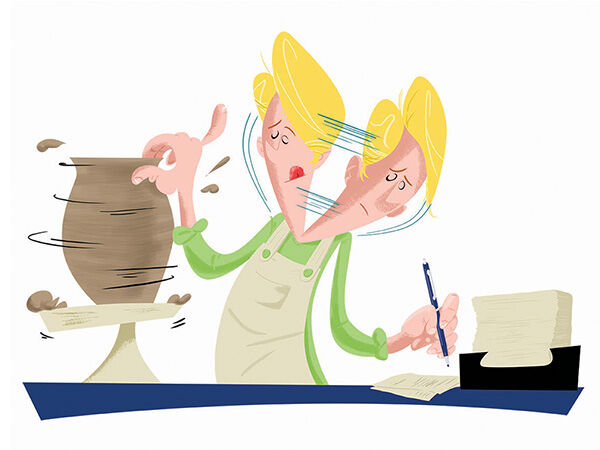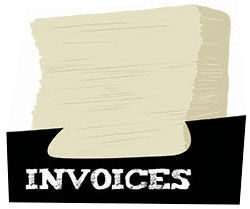Are you a Hobbyist or in Business?
by Daniel Grant
Illustrations by Bill Kuffel
It's all well and good to say that artists need to be businesslike rather than bohemian, but those who want the Internal Revenue Service (IRS) to accept work-related deductions on their federal tax returns do not have a choice. If the IRS believes someone is just a hobbyist rather than in business, those deductions will not be allowed.
''The IRS has rules about hobbyists versus professionals,'' said New York City accountant Steven Zelin (www.thesingingcpa.com). ''Basically, the IRS wants to know if the taxpayer intends to make a profit as opposed to just make art.'' Artists are in business as soon as they earn money from their work in the form of sales, grants, or fees if they give a public demonstration. Some sort of transaction is required; if there is no money, there is no business. A business still may be a hobby, however, unless it is conducted in a certain way, and the difference between the two determines whether or not expenses may be deducted.
Understanding Business Benchmarks
There are nine criteria that the IRS applies in order to separate professionals from hobbyists. The artist need not answer ''yes'' to every question in order to legitimately deduct business-related expenses, and spending more money than one takes in does not disqualify someone from claiming to be in a real profit-oriented business. ''In every business, you expect to have losses in the first few years,'' said New York City accountant Todd Thurston (www.taxtodd.com).
- Is the activity carried on in a businesslike manner?
- Does the artist intend to make the artistic activity profitable?
- Does the individual depend on income generated by the artistic work?
- Are business losses to be expected, or are they due to circumstances beyond the artist's control?
- Are business plans changed to improve profitability?
- Does the artist have the knowledge to make the activity profitable?
- Has the artist been successful in previous professional activities?
- Does the activity generate a profit in some years and, if so, how much of one?
- Will the artist make a profit in the future?
What to Provide for Proof
The IRS demands proof that an artist makes a genuine effort to earn a profit in three years out of a five-year span. If an artist has had three consecutive years of losses, the federal agency will want to see some sort of profit in the next year. ''Losses that an artist has already taken won't be challenged if an audit takes place,'' he said, ''only losses claimed going forward.''
Zelin noted that creating a business plan, which a company or sole proprietor would need when applying for a bank loan, is useful if the IRS needs proof of an artist's profit-making intent. Another helpful tool artists can utilize if they need to furnish proof of an operable business is an executive summary.
In an executive summary, draft a document which clearly spells out the nature of your business and your expectations of potential earnings. Also include a description of business operations such as your studio, outline how much time you spend working in your studio each day or per week, explain how artwork is transported to one site or another, offer website information, exhibition venues, and how payment is accepted.
Another important detail to incorporate in your executive summary would be to break down your staffing and management needs and use. For example, if you employ or contract a studio assistant or a business manager you could note that here. Also add your revenue forecasts, expected expenses, and your marketing plan - how the artwork produced will be made known to prospective buyers. If you anticipate reaching milestones including special exhibitions and receiving grant awards or prizes, this is the perfect place to put those thoughts down.
How to Answer When Your Intent is Questioned
The IRS does not define what makes an artist a professional, but certain elements help in the determination of whether or not there is a serious intent on earning a profit. ''Having a Bachelors Degree in Fine Arts is something, but having a Masters Degree in Fine Arts is more,'' said New York accountant Susan Lee (www.freelancetaxation.com).
''Having a website helps, especially if the website is set up for making sales, as is having a separate business credit card and business bank account. Using the services of a lawyer or an accountant in setting up or running your business shows you are serious,'' she said. ''Belonging to an artist organization, subscribing to an industry-related magazine, or going to professional conferences is helpful, because it builds a picture of you doing everything you can do to be on top of the market.''
When to Take it to Court
If an artist believes that the IRS has denied business-related expense tax deductions unfairly, he or she may challenge the auditor's decision in tax court, which requires petitioning the court and paying a $60 filing fee within 90 days of receiving the IRS' Notice of Deficiency. Forms and instructions are available online at www.ustaxcourt.gov.
Tax court generally operates in the manner of a small claims court - there is no jury, and taxpayers tell the judge their story. However, many applicants to the tax court do hire lawyers to represent them.
Artists have gone to tax court with claims that they are not just hobbyists and won. Back in 1977, a precedent-setting decision was handed down with regard to a painter, Gloria Churchman, who had claimed losses of several hundred dollars in her tax filings in 1970 and 1971.
For all of her 20-year career, Churchman's income from art sales never had exceeded her losses, and the IRS also claimed that the artist was supported by her husband, a college professor. As a result, IRS auditors labeled Churchman a hobbyist and her deductions for art-related expenses were denied. However, when the artist took her case to tax court, it was ruled that Churchman pursued her art career ''with a bona fide intention and expectation of making a profit'' and the fact that she did not rely on sales of her artwork for her livelihood was irrelevant.
Lack of income, the court ruled, and ''a history of losses is less persuasive in the art field than it might be in other fields because the archetypal 'struggling artist' must first achieve public acclaim before her serious work will command a price sufficient to provide her with a profit.''
More recently, Cambridge, N.Y., painter and Hunter College art professor Susan Crile successfully challenged an IRS auditor's rejection of her claimed deductions on her tax returns for art-related expenses on the basis that her work as an artist was ''an activity not engaged in for profit.'' Noting that she had received fellowships from the National Endowment for the Arts in 1982 and 1989 and that more than two dozen museums had her work in their collections, including the Metropolitan Museum of Art, the Hirshhorn Museum and Sculpture Garden, and the Phillips Collection, the tax court ruled that ''[in] a qualitative as well as a quantitative sense, we conclude that the balance of factors favors [Crile] and that she has met her burden of proving that in carrying on her activity as an artist, she had an actual and honest objective of making a profit. We therefore hold that she was in the trade or business of being an artist.''
Tax Audit Armor
What's in an executive summary?
- Description of your business operations
- Staffing and management information
- Revenue forecasts
- Marketing plans
- Projected expenses
- Expected milestones
Work-Related Business Expenses
- Material costs
- Studio rent
- Vehicle(s)
- Insurance
- Travel expenses
- Advertising
- Marketing
- Photography
- Postage
- Shipping
Have a question regarding this project? Email Customer Service.
Copyright Permissions
All works of authorship (articles, videos, tutorials and other creative works) are from the Fire Mountain Gems and Beads® Collection, and permission to copy is granted for non-commercial educational purposes only. All other reproduction requires written permission. For more information, please email copyrightpermission@firemtn.com.


